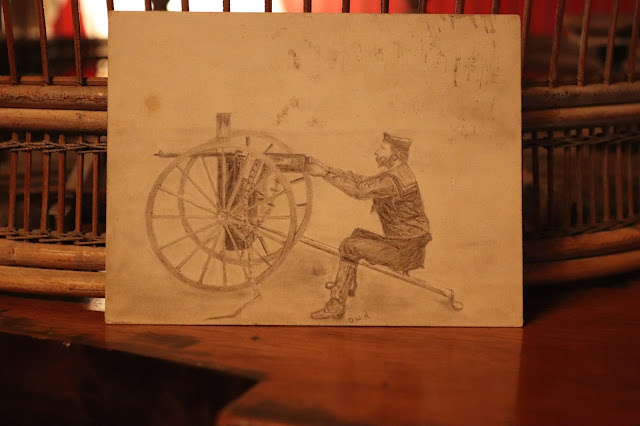If you want to know how someone sees the world, give them a pencil.
Right from an early age, we have a love of drawing. It's true that sometimes children's drawings can be a bit peculiar, but they are exactly how they view the world around them and there is something rather special about that.
A few years ago, we bought a job-lot of books and bits-and-bobs at our local auction. There were some rather lovely things amongst them and, since they only cost a couple of pounds, they were better than bargainous! In them was a collector copy of a biography of the sculptor Alfred Gilbert, who famously created the statue of Eros in Picadilly Circus. As part of the book, there is a hand drawn sketch of one of his designs. It is somehow both messy and precise, giving an idea of how he worked through his ideas until the reached the desired conclusion.
But this was not the greatest treasure in the collection - at least not for us! Buried in amongst the rest of the published and printed books was a sketchbook belonging to a young girl. We later found out that she had been distantly related to Alfred Gilbert, and that this was how the two books came to appear side by side. Her name was Eleanor, and her sketchbook is something else! Through the pages of her pictures, we can see what it was like to be a child during World War Two. Looking at the things she dreamed of, the observations she made, and the cultural background which is so difficult to recapture.
We were so taken with this discovery, we looked into where these had come from and came to know Eleanor rather well through our research and her belongs which we had just acquired.
So sketches can tell us a lot about not only the people who drew them, but also the times they lived in. They are often not intended to be shared beyond someone's immediate circle and so can be entirely honest. There is no need for vanity or pomp when there is only an audience who knows you already.
This picture is a pen and ink of La Tour Magne (The Great Tower), Nîmes, dated 1810. On the reverse is another piece of paper which has a religious poem written on. I have often wondered about this one. It was sold as the work of someone who had undertaken The Grand Tour, but the further I delve into the history of Nîmes at that time, the more I wonder whether or not this was the work of a military man not a tourist. Nîmes is a truly ancient settlement, and its history is full of bloodshed and bitterness. Was this someone's attempt to find a quiet moment of solace in what was an otherwise dangerous and fraught world?
Some of the most notable sketches come from those who were on campaign. There were long periods when servicemen were not required to fight and a sketchbook and pencil were readily at hand. The line between fear and valour has always been paper-thin, and the destraction of art could easily have offered a way for military men to tip the balance.
Of course, not all soldier's sketches were so serious. I have a soft spot for the one below, because it makes me thing of my own Great-Great-Grandfather who was in the Boer War and later became a recruiting sergeant. I like to think he would have wanted all the soldiers to be as happy as this chappy.
But it's not just soldiers who are sketchers, and they are certainly not always the subject. I have no idea who this lady was, who drew her, nor why she is in that particular pose with her stick, but she certainly has plenty of stories to tell. Perhaps that is why sketches are just so inspiring, because they give us a unique outlook on the way the world was seen, and ignite a unique voice in which to tell our stories.




,%20N%C3%AEmes.%20Dated%201810..jpg)



Comments
Post a Comment